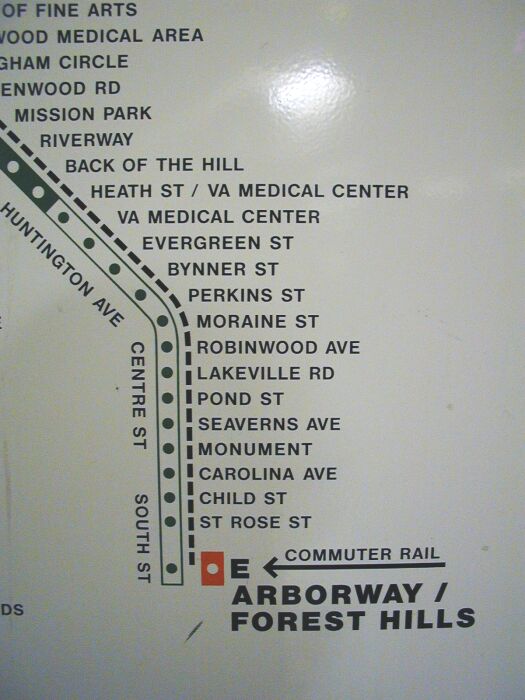|
|
 |
|
|
|
|
|
|
|
|
|
|
|
|
|
 |
|
|
|
|
|
|
|
|
|
|
|

MBTA map of Green Line service, showing pre-1986 stops beyond Heath Street on the E-Arborway line. Photo by Sean Sullivan (2002)
|
19th Century Origins of the Arborway Line
The Arborway line is not a new concept. Streetcar service began on this route in the 19th century, and Jamaica Plain was one of the first suburban regions in America with streetcar service to a major downtown. A streetcar line along South Huntington, Centre St and South St was an integral part of Boston's streetcar network for about a century. E Line Temporarily Suspended in 1985 Service on the E line was "temporarily" suspended by the MBTA in 1985, due to two construction projects along Huntington Avenue. In one project, the City of Boston rebuilt Huntington Ave east of Brigham Circle, in a region where the streetcar runs in mixed traffic with cars. In a second project, the portal ramp (where the streetcars exit the subway tunnel) was rebuilt to allow the new (and heavier) Type 7 streetcars to run on the E line. 1989: Green Line restored only to Heath Street While the E line was suspended, the route was served by a replacement bus between Copley Square and Forest Hills. Streetcar service was restored over the inner part of the line (to Brigham Circle) in 1986, and to the current streetcar terminus (Heath Street) in 1989. The remainder of the line has never been re-opened. Until 1989, the replacement bus service used a standard Green Line fare structure. When Green Line service settled into its present configuration, the replacement bus service (still needed to serve the Jamaica Plain portion of the streetcar route) was changed to semi-permanent status. Known as route number #39, the line started using a standard bus fare structure. (As a historical remnant, however, subway passes are still valid on #39 -- the only numbered bus route where this is true over the full line.) System Trend Against Street-Running Streetcars In effect, the MBTA had phased out the Arborway Line between Heath Street and Forest Hills. Still officially "temporarily" suspended, the perception gradually strengthened that the line was forever closed. A similar situation had happened before with the "A" line, which was "temporarily" replaced with substitute bus service in 1969 (today's bus route #57) due to a shortage of Green Line streetcars, and never re-opened. In both cases, it appeared that a temporary change in service would become permanent. The closure of the Arborway line fits the general trend of Boston streetcar service over the past century. When the subway first opened (1897), before the dawn of the automobile, a dense network of streetcars formed the backbone of Boston's transportation system. Over time, almost all of that system has been abandoned, as streets were handed over to cars. With one exception, streetcars survived only where they operated in dedicated lanes (removed from vehiclular traffic). Thus, streetcars remain in the central subway (below ground) and along the Lechmere Viaduct (above ground), finally ending at Lechmere Station (where the streetcars used to fan out onto the streets of Cambridge and Somerville). To the west, streetcars run in the median along Commonwealth Ave (B line), Beacon Street (C line), and Huntington Ave to Brigham Circle (E line). Streetcars also operate on grade-separated lines that are unrelated to streets -- the Mattapan Line, and the old Highland Branch train line (D line). These routes survived because the trains did not run in the same lanes as cars. Indeed, the only surviving street-running segment of streetcar service is the outer 2/3-mile section of the E line, between Brigham Circle and Heath Street. 2001: State Requires New Arborway Service The decision to restore the Arborway line was made in 2001, and came as something of a surprise. In fact, the seeds of this decision went back a decade. In the early 1990's, the state committed to the restoration of Arborway streetcar service as part of the environmental protection process surrounding the Big Dig. The MBTA sought to escape from this agreement, and was visibly committed to the use of busses on the line. However, the MBTA's request was turned down by the state Department of Environmental Protection in a 2001 decision. In response to this decision, the MBTA agreed to work seriously towards the restoration of Arborway service. General Manager Michael Mulhern has been very straightforward about this commitment, and there is now every reason to believe that Green Line service will return to the Arborway corridor within the next few years. Since the Arborway Line has not operated since 1985, the design must comply with federal regulations mandating full accessibility for persons with disabilities on all new transit projects. As a result, the new line obviously cannot operate in the manner of pre-1986 service, when the streetcars simply let passengers on and off in the street. Thus, the restoration of the Arborway line is effectively like designing an entirely new streetcar route. Operations and station locations are being addressed from a new perspective, and are unlikely to mirror the historical patterns.
|